The Killing of the Disciples of Christ
 Andrew |
 Bartholomew |
 Matthew |
 James A |
 James Z |
 John |
 Matthais |
 Peter |
 Philip |
 Simeon |
 Thomas |
 Jude |
You will find that most of the disciples were martered. You need to question why these men, who were soo close to Jesus were killed. This page is dedicated to the memory of Jesus' trusted disciples.
If you haven't read Death Forward of this series, please go back and read it first.
Thomas is included in the list above, but Jude and
Thaddeus are one and the same person. We found that
the James Z and particulary James A ( James the Less) are very important to
our story. We give a full page to him following this one.
We don't know who the John is here, but we think it possibly is
John the Evangelist. Philip, Peter, Thomas and James A are
writers in the Nag Hammidi scrolls and were very close to Jesus.
James, Simeon, Jude and Jose are all
step-brothers of Jesus and we found that 'Jose' is Joseph,
better known as Josephus. Born in
37 A.D., he is the next to the youngest of the four step-brothers
of Jesus, as they are listed in order of their birth.
We confirmed that Simeon was James successor as leader of the
church, James A being the oldest son of Mary and Cleophas.
Cleophas is the brother of Joseph, Jesus' so-called step-father.
Because this connection is very important, Josephus has his own page also. There is no doubt in our minds that Josephus knew Jesus and was related to him. It is also important to remember that Josephus was the military leader of the Zealots then he switches alliance to Rome to save himself. The disciples had all become members of the Zealot (freedom ) party.. Throughout the scriptures Josephus (Jose) is the only brother who doesn't involve himself with the 'Jesus' movement. He is afraid of Rome so he turns his alligence to them.
We have been able to locate information on the James's, Thomas, Jude, Nathanael, Matthew, John, Philip, Andrew, Simon, Peter, Matthias and Bartholomew (see below ).
Note; most of these references were copied from
the catholic encyclopedia where they do not deny that Jesus
had real blood brothers. But they also admit something else.
Something very important! The disciples were Gnostic, not christians.
Jesus was not a christian nor did he found this cult religion.
We have Paul, Rome and the Emporer Constintine to blame for this.
Note; "The Catholics only declare their patrons christians; ... Moreover, the Christianity of which we speak is that which we find realized in the Catholic Church alone; hence, we are not concerned here with those forms which are embodied in the various non-Catholic Christian sects, whether schismatical or heretical." (How do you like them apples?)
Thomas Didymus
Profile; Patronage ( Patron Saint ) against doubt, architects, blind people, builders, construction workers, Ceylon East Indies, geometricians, India, masons, Pakistan, people in doubt, Sri Lanka, stone masons, stonecutters, surveyors, theologians.
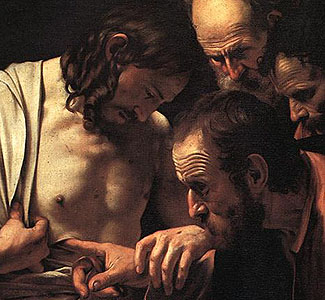 "Judas Thomas, as he is called elsewhere in Syriac
tradition, as the twin brother of Jesus."
The principal document concerning him is the
Acta Thomae",
preserved to us with some variations both in Greek and in Syriac,
and bearing unmistakeable signs of its Gnostic origin...from
Thomas
"Judas Thomas, as he is called elsewhere in Syriac
tradition, as the twin brother of Jesus."
The principal document concerning him is the
Acta Thomae",
preserved to us with some variations both in Greek and in Syriac,
and bearing unmistakeable signs of its Gnostic origin...from
Thomas 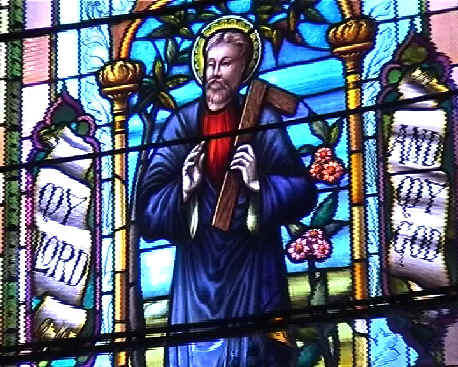 This the first admittance by Catholic writers that Thomas is
infact Gnostic as was his brother Jesus. The writers delibertly
distance Thomas from Jesus and portray him as older, so they
can claim he isn't Jesus's twin brother even though the sentence
above is plainly stated in the Catholic encyclopedia.
His symbol is the builder's square,
from an ancient story that he built a palace for King Guduphara
in India. Other historical and scriptural references also place
him in India.
This the first admittance by Catholic writers that Thomas is
infact Gnostic as was his brother Jesus. The writers delibertly
distance Thomas from Jesus and portray him as older, so they
can claim he isn't Jesus's twin brother even though the sentence
above is plainly stated in the Catholic encyclopedia.
His symbol is the builder's square,
from an ancient story that he built a palace for King Guduphara
in India. Other historical and scriptural references also place
him in India.
JUDE THADDEUS
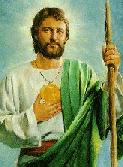 Profile;
Son of Cleophas, who died a martyr, and Mary.
(Cleophas, the brother of Joseph)
Brother of Saint James the Lesser; nephew of Joseph; deceased.
(James, the brother of Jude -- Jude 1:1.) Most Catholic commentators
identify Jude with the "Judas Jacobi", the "brother of James"
(Luke 6:16; Acts 1:13), called thus because his brother James
was better known than himself in the primitive Church.
Profile;
Son of Cleophas, who died a martyr, and Mary.
(Cleophas, the brother of Joseph)
Brother of Saint James the Lesser; nephew of Joseph; deceased.
(James, the brother of Jude -- Jude 1:1.) Most Catholic commentators
identify Jude with the "Judas Jacobi", the "brother of James"
(Luke 6:16; Acts 1:13), called thus because his brother James
was better known than himself in the primitive Church.
Of cource if he is the son of Cleophas that would make him Joseph's nephew. This was our first clue that Mary married Cleophas after Joseph died.
"Brother of James" denotes him as the brother
of James kat exochen who was well-known to the Hebrew Christians to whom the
Epistle of St. Jude was written. This James is to be identified
with the Bishop of the Church of Jerusalem (Acts, xv, 13; xxi,
18), spoken of by St. Paul as "the brother of the Lord" (Gal.
i, 19), who was the author of the Catholic Epistle of St. James.
and is regarded amongst Catholic interpreters as the Apostle
James the son of Alpheus (Cleophas) also called
St. James the Less.
Only the catholics call him bishop. This is denounced in
the Nag Hammidi scrolls by Jesus in the
The Apocalypse of Peter
. quote; "And there shall be others of those who are outside our number who name
themselves bishop and also deacons, as if they have received their authority from God. They bend
themselves under the judgment of the leaders. Those people are dry canals."
From a fact of Hegesippus told by Eusebius (Hist. eccl., III, xix, xx, xxii) we learn that Jude was "said to have been the brother of the Lord according to the flesh", and that two of his grandsons lived till the reign of Trajan.
Blood relative of Jesus, and reported to look a lot like
him. May have been a 'fisherman'. (This will be discussed in a
minute where we find an allegorical meaning.)
Writer of canonical letter. Preached in Syria, Mesopotamia, and
Persia with Saint Simon. Healer. Exorcist. Could exorcise pagan
idols, which caused the demons to flee and the statues to crumble.
His patronage of lost or impossible causes traditionally derives
from confusion by many early Christians between Jude and Judas;
not understanding the difference between the names, they never
prayed for Jude's help, and devotion to him became something of a lost cause.
Died beaten to death with a club, then beheaded post-mortem in 1st
century Persia; relics at Saint Peter's, Rome, at Rheims, and
at Toulouse, France
Patronage; (Patron Saint) of desperate situations, forgotten causes, hospital workers, hospitals, impossible causes, lost causes. see Epistle of St. Jude
St. Simon the Apostle
 The name of Simon occurs in all the passages of the Gospel
and Acts, in which a list of the Apostles is given. To
distinguish him from St. Peter he is called (Matthew 10:4;
Mark 3:18) Kananaios, or Kananites, and Zelotes (Luke 6:15; Acts
1:13). Both surnames have the same signification and are a
translation of the Hebrew qana (the Zealous). The name does not
signify that he belonged to the party of Zealots, but that he
had zeal for the Jewish law, which he practised before his call.
Jerome and others wrongly assumed that Kana (Cana) was his native
place; were this so, he should have been called Kanaios.
The Greeks, Copts, and Ethiopians identify him with Nathanael of
Cana; the first-mentioned also identify him with the bridegroom
of the marriage of Cana, while in the "Chronicon paschale" and
elsewhere he is identified with
Simon Clopas. (Cleophas the brother of Joseph).
The name of Simon occurs in all the passages of the Gospel
and Acts, in which a list of the Apostles is given. To
distinguish him from St. Peter he is called (Matthew 10:4;
Mark 3:18) Kananaios, or Kananites, and Zelotes (Luke 6:15; Acts
1:13). Both surnames have the same signification and are a
translation of the Hebrew qana (the Zealous). The name does not
signify that he belonged to the party of Zealots, but that he
had zeal for the Jewish law, which he practised before his call.
Jerome and others wrongly assumed that Kana (Cana) was his native
place; were this so, he should have been called Kanaios.
The Greeks, Copts, and Ethiopians identify him with Nathanael of
Cana; the first-mentioned also identify him with the bridegroom
of the marriage of Cana, while in the "Chronicon paschale" and
elsewhere he is identified with
Simon Clopas. (Cleophas the brother of Joseph).
Another clear indication he is a step-brother. His usual attribute is the saw, since his body was said to have been sawed to pieces, and more rarely the lance. He is regarded as the patron of tanners His attendence at the wedding at Cana is also significant.
St. Andrew

The name "Andrew" (Gr., andreia, manhood, or valour), like other Greek names, appears to have been common among the Jews from the second or third century B.C. St. Andrew, the Apostle, son of Jonah, or John (Matt., xvi, 17; John, i, 42), was born in Bethsaida of Galilee (John, i, 44). He was brother of Simon Peter (Matt., x, 2; John, i, 40). Both were 'fishermen' (Matt., iv, 18; Mark, i, 16), and at the beginning of Jesus' public life occupied the same house at Capharnaum (Mark, i, 21, 29). From the fourth Gospel we learn that Andrew was a disciple of the Baptist, whose testimony first led him and John the Evangelist to follow Jesus (John, i, 35-40). Andrew at once recognized Jesus as the Messias, and hastened to introduce Him to his brother, Peter, (John, i, 41). Thenceforth the two brothers were disciples of Christ. On a subsequent occasion, prior to the final call to the apostolate, they were called to a closer companionship, and then they left all things to follow Jesus (Luke, v, 11; Matt., iv, 19, 20; Mark, i, 17, 18). Finally Andrew was chosen to be one of the Twelve; and in the various lists of Apostles given in the New Testament (Matt., x, 2-4); Mark, iii, 16-19; Luke, vi, 14-16; Acts, i, 13) he is always numbered among the first four.
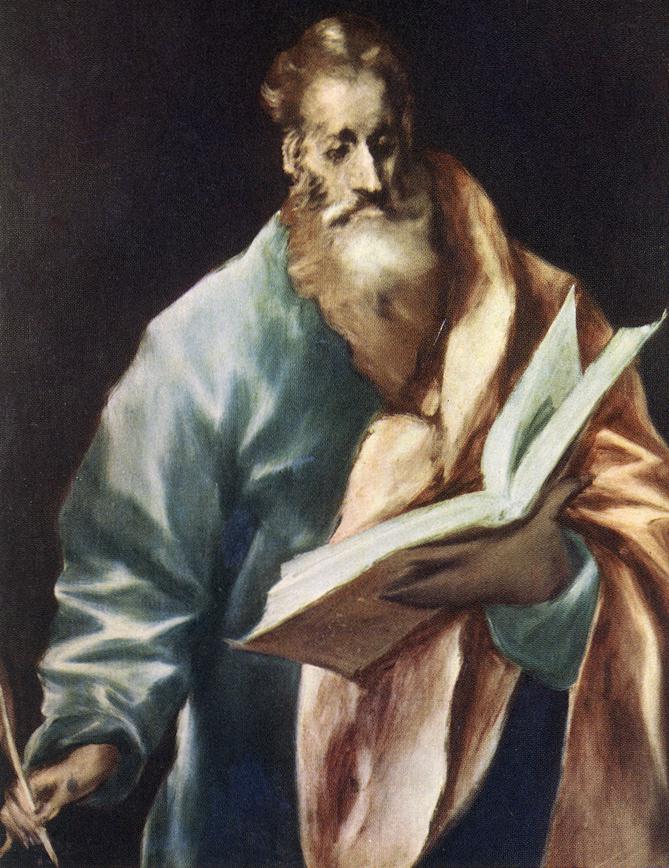 The Evangelist Matthew
The Evangelist Matthew
The apostle Matthew, also called Levi, was the son of Alphaeus and the brother of the apostle James the Less, or, James, son of Alphaeus , (Cleophas) brother of Joseph. By profession, Matthew was a tax collector before being called by Jesus to follow Him. from Matthew However, nowhere else do we find that he is a 'step-brother' of Jesus as we have thus far identified James and Jude, so this description makes it likely.
Compair the image of James and Simon above with this one. This presents the fact that Matthew is the son of Cleophas and his mother could be the same Mary that we have identified as the mother of Jude, Thomas, Simon, Jose and James....and Jesus.
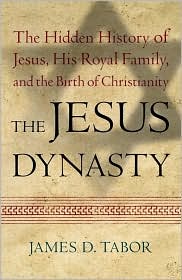 This is verified by James Tabor, chair of religious studies, University of North
Carolinia at Charlotte in his book The Jesus Dynasty chapter 4.
This is verified by James Tabor, chair of religious studies, University of North
Carolinia at Charlotte in his book The Jesus Dynasty chapter 4.
The Catholic encyclopedia confirmation of the family name; "However, we have also examples of individuals with two Hebrew names as, for instance, Joseph-Caiaphas, Simon-Cephas, etc." (Cleophas) It is probable that Mattija, (very close to the family name 'Matthias') "gift of Iaveh", was the name conferred upon the tax-gatherer by Jesus Christ when He called him to the Apostolate, and by it he was thenceforth known among his Christian brethren, Levi being his original name. Matthew
Matthew, the son of Alphaeus (Cleophas) (Mark 2:14) called Levi, was a Galilean, although Eusebius informs us that he was a Syrian.(Not true) As tax-gatherer at Capharnaum. This is just one more instance of the writers of the NT disconnecting the 'brothers'. It is one way of making the book of Matthew appear to be authentic, however it was edited like the others.
The account in the three Synoptics is identical, the vocation of Matthew-Levi being alluded to in the same terms. Hence Levi was the original name of the man who was subsequently called Matthew; the Maththaios legomenos of Matthew 9:9, would indicate this....confirmed above representing the tribe of Gad.
Matthew probably remained in the Holy Land, as tradition says, for 15 years and after this, encouraged by the reports of the success of other Christian leaders among the Jews (the Diaspora) and, also, among the Gentiles, he went forth on several missionary journeys. It is certain that he went to Persia and the mysterious area in Persia known as "Ethiopia." It is, also, possible that he traveled to the Ethiopia in Africa as the Roman Catholic tradition indicates and there is, also, a belief that Matthew was martyred in Egypt upon his return from Ethiopia in Africa, but, this, is not certain. There is a tradition which says that Matthew was martyred in Parthia.
from the Catholic encyclopedia; Of Matthew's subsequent career we have only inaccurate or legendary data. St. Irenæus tells us that Matthew preached the Gospel among the Hebrews, St. Clement of Alexandria claiming that he did this for fifteen years, and Eusebius maintains that, before going into other countries, he gave them his Gospel in the mother tongue. Ancient writers are not as one as to the countries evangelized by Matthew, but almost all mention Ethiopia to the south of the Caspian Sea (not Ethiopia in Africa), and some Persia and the kingdom of the Parthians, Macedonia, and Syria. According to Heracleon, who is quoted by Clement of Alexandria, Matthew did not die a martyr, but this opinion conflicts with all other ancient testimony.
Lipsius holds that this "Martyrium S. Matthæi",
which
contains traces of Gnosticism, must have been published in the
third century. There is a disagreement as to the place of St.
Matthew's martyrdom and the kind of torture inflicted on him,
therefore it is not known whether he was burned, stoned, or
beheaded. The Roman Martyrology simply says: "S. Matthæi, qui
in Æthiopia prædicans martyrium passus est". Various writings
that are now considered apocryphal, have been attributed to St.
Matthew."
..a·poc·ry·phal - a catholic word -
'Of questionable authorship or authenticity.
Erroneous; fictitious: Not canonical. Hence: Of doubtful
authority; equivocal; mythic; fictitious; spurious; false'.
NOT!
Matthew was a gifted writer, an ardent disciple and was perhaps the best educated of any of the Twelve Apostles. He was the writer of The Gospel of Matthew, according to the Biblepath website. However we are not sure if this is the same Matthew but we are sure that the content was edited because of the above 2 paragraphs in this identification and the one about Jerome, a catholic priest, below described as 'Greek apocryphal'.
From His Pre-A.D.70 Work, Gospel According to Matthew;
"A comparison of the Synoptic gospels reveals that Matthew
refers to the Sadducees the most. It seems odd that he would do
so if he wrote after the fall since they had already disappeared
after the fall of Jerusalem because of their political
cooperation with Rome."
"While Clement of Alexander suggested that the Gospels with genealogies were written first (Eusebius, Ecclesiastical History VI. xiv.5), of early writers on Irenaeus suggests an approximate date for the writing of Matthew. He asserts that it was written while Peter and Paul were preaching in Rome, which would require a date before A.D.64." (The Gospel According to Matthew, The Living Word Commentary; Austin, TX: Sweet PC; p. 14)
Writing for his countrymen of Palestine, St. Matthew composed his Gospel in his native Aramaic, the "Hebrew tongue" mentioned in the Gospel and the Acts of the Apostles. Soon afterward, about the time of the persecution of Herod Agrippa I in 42 AD, he took his departure for other lands. Another tradition places the composition of his Gospel either between the time of this departure and the Council of Jerusalem, i.e., between 42 AD and 50 AD or even later. Definitely, however, the Gospel, depicting the Holy City with its altar and temple as still existing, and without any reference to the fulfillment of our Lord's prophecy, shows that it was written before the destruction of the city by the Romans in 70 AD, and this internal evidence confirms the early traditions.
There is a tradition that points to Ethiopia as his field of labor; other traditions mention of Parthia and Persia. It is uncertain whether he died a natural death or received the crown of martyrdom.
Tischendorf reproduced a Latin document entitled: "De Ortu beatæ Mariæ et infantia Salvatoris", supposedly written in Hebrew by St. Matthew the Evangelist, and translated into Latin by Jerome, the priest. It is an abridged adaptation of the "Protoevangelium" of St. James, which was a Greek apocryphal of the second century. Indeed, it dates back to the Protoevangelium of James, an apocryphal book written in 120 A.D. This work states that Joseph was a widower who had children from a previous marriage This ( what they call ) pseudo-Matthew dates from the middle or the end of the sixth century which makes it authentic, ie., written by a true disciple.
St. Matthew is represented under the symbol of a winged man, carrying in his hand a lance as a characteristic emblem. No further allusion is made to Matthew in the Gospels, except in the list of the Apostles.
John the Evangelist and James Z
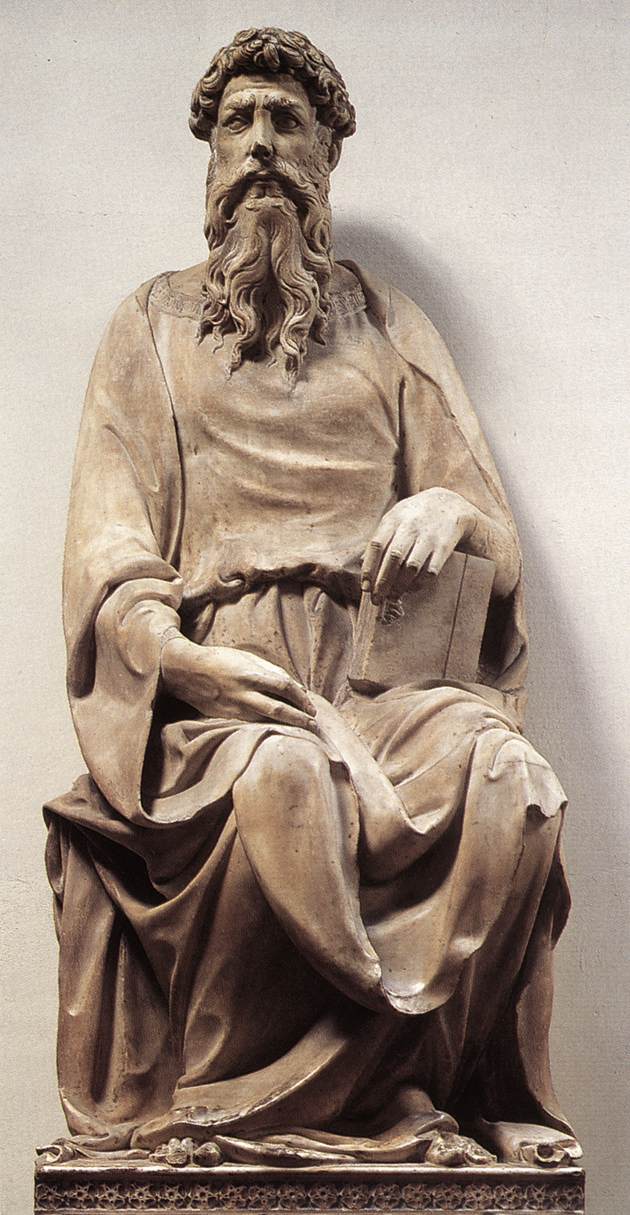 John was the son of Zebedee and Salome, and the brother of
James the Greater. In the Gospels the two brothers are often
called after their father "the sons of Zebedee" and received
from Christ the honourable title of Boanerges, i.e. "sons of
thunder" (Mark, iii, 17). Originally they were 'fishermen' and
fished with their father in the Lake of Genesareth. According to
the usual and entirely probable explanation they became, however,
for a time disciples of John the Baptist, and were called by
Christ from the circle of John's followers, together with Peter
and Andrew, to become His disciples (John, i, 35-42).
John was the son of Zebedee and Salome, and the brother of
James the Greater. In the Gospels the two brothers are often
called after their father "the sons of Zebedee" and received
from Christ the honourable title of Boanerges, i.e. "sons of
thunder" (Mark, iii, 17). Originally they were 'fishermen' and
fished with their father in the Lake of Genesareth. According to
the usual and entirely probable explanation they became, however,
for a time disciples of John the Baptist, and were called by
Christ from the circle of John's followers, together with Peter
and Andrew, to become His disciples (John, i, 35-42).
The first disciples returned with their new Master from the Jordan to Galilee and apparently both John and the others remained for some time with Jesus (cf. John ii, 12, 22; iv, 2, 8, 27 sqq.). Yet after the second return from Judea, John and his companions went back again to their trade of fishing until he and they were called by Christ to definitive discipleship (Matt., iv 18-22; Mark, i, 16-20). In the lists of the Apostles John has the second place (Acts, i, 13), the third (Mark, iii, 17), and the fourth (Matt., x, 3; Luke, vi, 14), yet always after James with the exception of a few passages (Luke, viii, 51; ix, 28 in the Greek text; Acts, i, 13). (Catholic encyclopedia) Which makes Mark, Luke and this Matthew non-authentic.(Greek)
From James Z being thus placed first, the conclusion is drawn that John was the younger of the two brothers. In any case John had a prominent position in the Apostolic body.
The Fourth Evangelist has shown us most clearly how close the relationship was in which he always stood to his Lord and Master by the title with which he is accustomed to indicate himself without giving his name: "the disciple whom Jesus loved" . Some wish to draw the conclusion from this that John left Palestine between the years 52 and 55. (But the disciple who Jesus Loved may not be this one.)
Of the other New-Testament writings, it is only from the three Epistles of John that anything further is learned concerning the person of the Apostle. We may be permitted here to take as proven the unity of the author of these three writings handed down under the name of John and his identity with the Evangelist. Both the Epistles and the Apocalypse, however, presuppose that their author John belonged to the multitude of personal eyewitnesses of the life and work of Christ (cf. especially I John, i, 1-5; iv, 14), that he had lived for a long time in Asia Minor, was thoroughly acquainted with the conditions existing in the various Christian communities there, and that he had a position of authority recognized by all Christian communities as leader of this part of the Church.
They left this out..from the Nag Hammidi John and the Apocalypse A Gnostic text.
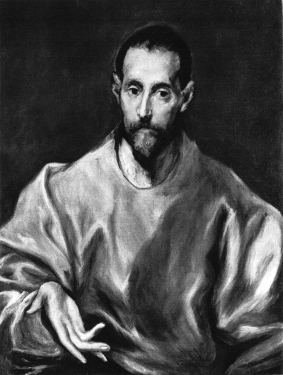 St. James Zebedee (Z) was the first of the twelve to be martyred.
He died by decapitation in 42 A.D. under Herod Agrippa. St.
James is referred to as the greater because he was called by
Christ before the other apostle of the same name. He preached
the Gospel in Samaria, Judea and Spain. St. James has a Church
dedicated to his name in Compostella, Spain. He is the Patron
Saint of Guatemala, Laborers, Nicaragua, Pilgrims, Rheumatism,
and Spain. St. James is listed in the Roman Canon (Eucharistic
Prayer I).
St. James Zebedee (Z) was the first of the twelve to be martyred.
He died by decapitation in 42 A.D. under Herod Agrippa. St.
James is referred to as the greater because he was called by
Christ before the other apostle of the same name. He preached
the Gospel in Samaria, Judea and Spain. St. James has a Church
dedicated to his name in Compostella, Spain. He is the Patron
Saint of Guatemala, Laborers, Nicaragua, Pilgrims, Rheumatism,
and Spain. St. James is listed in the Roman Canon (Eucharistic
Prayer I).
The (First) Apocalypse of James in the Nag Hammidi writings is James Zebedee (Z) because Jesus says, "I have given you a sign of these things, James, my brother. For not without reason have I called you my brother, although you are not my brother materially. And I am not ignorant concerning you; so that when I give you a sign - know and hear."
His father, Zebedee, could afford hired men (Mark 1:19-20), and his brother was personally known to the High Priest (John 18:15-16)--James shared with John the nickname Boanerges, 'Sons of Thunder.' This title, bestowed by Christ (Mark 3:17), suggests that the brothers were impetuous and hot-tempered, and we may see this exemplified in different ways in the two incidents described in Luke 9:54 and Mark 10:35-41.
James was put to death by the sword at the command of Herod Agrippa (Acts 12:2), probably in the year 42. Towards the end of the second century, Clement of Alexandria, relying on the information of 'those before him,' states that the apostle's accuser was himself converted, and suffered at the same time as James...more about James Z
Peter
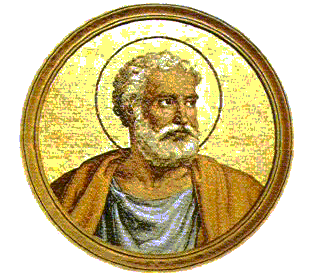 St. Peter's true and original name was Simon, sometimes
occurring in the form Symeon. (Acts 15:14; II Peter 1:1). He was
the son of Jona (Johannes) and was born in Bethsaida (John 1:42,
44), a town on Lake Genesareth, the position of which cannot be
established with certainty, although it is usually sought at
the northern end of the lake. The Apostle Andrew was his
brother, and the Apostle Philip came from the same town.
St. Peter's true and original name was Simon, sometimes
occurring in the form Symeon. (Acts 15:14; II Peter 1:1). He was
the son of Jona (Johannes) and was born in Bethsaida (John 1:42,
44), a town on Lake Genesareth, the position of which cannot be
established with certainty, although it is usually sought at
the northern end of the lake. The Apostle Andrew was his
brother, and the Apostle Philip came from the same town.
Simon settled in Capharnaum, where he was living with his mother-in-law in his own house (Matthew 8:14; Luke 4:38) at the beginning of Christ's public ministry (about A.D. 26-28). Simon was thus married, and, according to Clement of Alexandria (Stromata, III, vi, ed. Dindorf, II, 276), had children. The same writer relates the tradition that Peter's wife suffered martyrdom (ibid., VII, xi ed. cit., III, 306).
Concerning these facts, adopted by Eusebius (Hist. Eccl., III, xxxi) from Clement, the ancient Christian literature which has come down to us is silent. Simon pursued in Capharnaum the profitable occupation of fisherman in Lake Genesareth, possessing his own boat (Luke 5:3). Peter was one of the three Apostles (with James and John) who were with Christ on certain special occasions including the 'raising of the daughter of Jairus (Mary Magdalene) from the dead'.
But Peter hates women and doesn't understand why Mary should have more privledge than him. Mary was afraid of Peter, and she says to Jesus, " Peter makes me hesitate; I am afraid of him, because he hates the female race." Jesus replies, that "whoever the Spirit inspires is divinely ordained to speak, whether man or woman". Gospel of Philip
This passage from the The Gospel of Mary in the Nag Hammidi texts confirms Peter doesn't understand Jesus' teachings and said to Mary, "Sister, we know that the Saviour loved you more than the rest of women. Tell us the words of the Saviour which you remember - which you know (but) we do not, nor have we heard them." Mary answered and said, "What is hidden from you I will proclaim to you." And she began to speak to them these words: "I," she said, "I saw the Lord in a vision and I said to him, 'Lord, I saw you today in a vision.'
He answered and said to me, 'Blessed are you that you did not waver at the sight of me. For where the mind is, there is the treasure.' I said to him, 'Lord, how does he who sees the vision see it through the soul or through the spirit?' The Saviour answered and said, 'He does not see through the soul nor through the spirit, but the mind which [is] between the two - that is [what] sees the vision...'Which again confirms Mary's position over Peter because she understands the teachings.
The Roman church contends that Peter was installed as 'head' of the apostles, but we find this to be untrue. In spite of his so-called firm faith in Jesus, Peter had so far no clear knowledge of the mission and work of the Saviour. The sufferings of Christ especially, as contradictory to his worldly conception of the Messias, were inconceivable to him, and his erroneous conception occasionally elicited a sharp reproof from Jesus (Matthew 16:21-23) more than once. (catholic encyclopedia)
He at first took to flight with the other Apostles (John 18:10-11; Matthew 26:56); then turning he followed his captured Lord to the courtyard of the High Priest, and there denied Christ, asserting explicitly and swearing that he knew Him not (Matthew 26:58-75; Mark 14:54-72; Luke 22:54-62; John 18:15-27). This denial was of course due, not to a lapse of interior faith in Christ, but to exterior fear and cowardice.
Our question then is, why should a coward be placed at the head of any church? As we mentioned above, Jesus tells the followers not to go to anyone else but Jacob ( James ) his brother and leader of the true church. Gospel of Thomas
A confirmation of the position accorded to Peter by Luke, in the Acts, ( sheer fabrication by Paul's doctor who is not a true apostle) is afforded by the testimony of St. Paul (Gal., i, 18-20). (another reason it isn't true) After his conversion and three years' residence in Arabia, Paul came to Jerusalem "to see Peter". Here the Apostle of the Gentiles (Paul) clearly designates Peter as the authorized head of the Apostles and of the early Christian Church. This substantiates our claim that Peter was captured by Paul and MADE the apostle of the gentiles, which was not Jesus' intention at all.
According to the catholic encyclopedia; Peter founded the Church of Antioch,... indicates the fact that he laboured a long period there, and also perhaps that he dwelt there towards the end of his life and then appointed Evodrius, the first of the line of Antiochian bishops, head of the community. This latter view would best explain the tradition referring the foundation of the Church of Antioch to St. Peter. Nowhere does any document say he founded the church of Rome.
Peter writes in the Nag Hammidi, and this tells us he is very close to Jesus but what he says is not consistant with Roman theology or dogma. This is our most copied quote that Jesus speeks to Peter; It shows dissapproval and complete contradiction of the Roman (church).
"But others shall change from evil words
and misleading mysteries. Some who do not understand mystery
speak of things which they do not understand, but they will
boast that the mystery of the truth is theirs alone. And in
haughtiness they shall grasp at pride, to envy the immortal soul
which has become a pledge. For every authority, rule, and power
of the aeons wishes to be with these in the creation of the
world, in order that those who are not, having been forgotten
by those that are, may praise them, though they have not been
saved, nor have they been brought to the 'Way' by them, always
wishing that they may become imperishable ones. For if the
immortal soul receives power in an intellectual spirit -. But
immediately they join with one of those who misled them."
(This is directly related to the false teachings of Paul)
"But many others, who oppose the truth and are the messengers of
error, will set up their error and their law against these pure
thoughts of mine, as looking out from one (perspective) thinking
that good and evil are from one (source). They do business in my
word. And they will propagate harsh fate." we invite you to read
the entire Apocalypse of Peter
Peter returned occasionally to the original Church of Jerusalem, the guidance of which was entrusted to St. James, the relative of Jesus, after the departure of the Prince of the Apostles (A.D. 42-44). The last mention of St. Peter in the Acts (xv, 1-29; cf. Gal., ii, 1-10) occurs in the report of the Council of the Apostles on the occasion of such a passing visit.
Philip
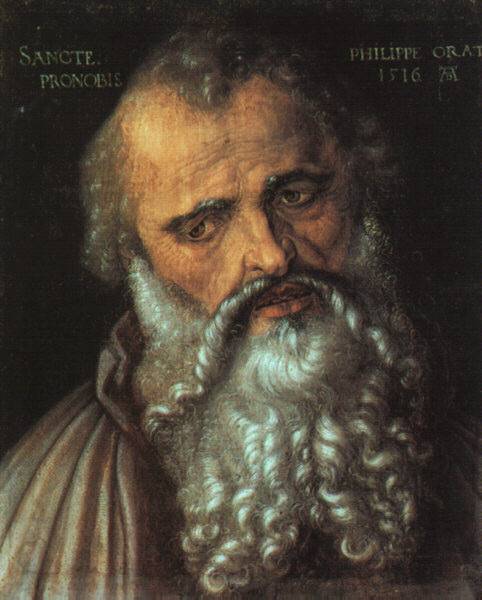 St. Philip was of Bethsaida, in Galilee, and called by Jesus
to follow him the day after St. Peter and St. Andrew. He was
at that time a married man, and had several daughters; but his
being engaged in the married state hindered him not. Philip had
no sooner discovered the Messias, than he was desirous to make
his friend Nathanael a sharer in his happiness, saying to him:
"We have found him of whom Moses in the law and the prophets
did write", that is, the Messias; (Jesus, the son of Joseph, of
Nazareth.)The marriage at Cana of Galilee happening three days
after, to which Jesus and his disciples were invited, St. Philip
was present at it with the rest. The year following, when
Jesus formed the college of apostles, Philip was appointed one
of that number, and from the several passages of the gospel,
he appears to have been particularly dear to his Master.
St. Philip was of Bethsaida, in Galilee, and called by Jesus
to follow him the day after St. Peter and St. Andrew. He was
at that time a married man, and had several daughters; but his
being engaged in the married state hindered him not. Philip had
no sooner discovered the Messias, than he was desirous to make
his friend Nathanael a sharer in his happiness, saying to him:
"We have found him of whom Moses in the law and the prophets
did write", that is, the Messias; (Jesus, the son of Joseph, of
Nazareth.)The marriage at Cana of Galilee happening three days
after, to which Jesus and his disciples were invited, St. Philip
was present at it with the rest. The year following, when
Jesus formed the college of apostles, Philip was appointed one
of that number, and from the several passages of the gospel,
he appears to have been particularly dear to his Master.
A correction to the wedding at Cana would be, 'to which Jesus invited the disciples'. ('of Nazareth' is incorrect, is not a town)
On the occasion of the selection and sending out of the twelve, Philip is included among the Apostles proper. His name stands in the fifth place in the three lists (Matt., x, 2-4; Mark, iii, 14-19; Luke, vi, 13-16) after the two pairs of brothers, Peter and Andrew, James and John. The Fourth Gospel records three episodes concerning Philip which occurred during the epoch of the public teaching of the Saviour. St. Philip
St. Philip accordingly preached the gospel in the two Phrygias, as Theodoret and Eusebius assure us from undoubted monuments. St. Polycarp, who was only converted in the year 80, enjoyed his conversation for some time, consequently St. Philip must have lived to a very advanced age. It appears, from a passage of Polyerates, quoted by Eusebius, that he was buried at Hierapolis, in Phrygia, which city was indebted to his relies for its preservation by continual miracles, as is averred by the author of the sermon on the twelve apostles, attributed to St. Chrysostom.
In his letter to St. Victor, written about 189-98, bishop Polycrates of Ephesus mentions among the "great lights", whom the Lord will seek on the "last day", "Philip, one of the Twelve Apostles, who is buried in Hieropolis with his two daughters, who grew old as virgins", and a third daughter, who "led a life in the Holy Ghost and rests in Ephesus." On the other hand, according to the Dialogue of Caius, directed against a Montanist named Proclus, the latter declared that "there were four prophetesses, the daughters of Philip, at Hieropolis in Asia where their and their father's grave is still situated." The statement of Bishop Polycrates carries in itself more authority, but it is extraordinary that three virgin daughters of the Apostle Philip (two buried in Hieropolis) should be mentioned, and that the deacon Philip should also have four daughters, said to have been buried in Hieropolis.
An arm of St. Philip was brought from Constantinople to Florence, in 1204, whereof we have an authentic history in the Bollandists. The Orientals keep his festival on the 14th of November; the Latins on the 1st of May, with St. James. His body is said to be in the church of SS. Philip and James, in Rome, which was dedicated to God under their name, in 560. The emperor Theodosius, in a vision, received from St. John the Evangelist, and St. Philip, the assurance of victory over the tyrant Eugenius, the morning before the battle, in 394, as Theodoret relates.
The Nag Hammidi Library has
The Gospel of Philip
which is in no way Christian even though this text uses the word.
The true defination would be 'Gnostic Christian'.
In this text Jesus says, "A Gentile does not die, for he has
never lived in order that he may die. He who has believed in the
truth has found life, and this one is in danger of dying, for
he is alive. Since Christ came, the world has been created, the
cities adorned, the dead carried out. When we were Hebrews, we
were orphans and had only our mother, but when we became
Christians, we had both father and mother."
If you will notice, this text says nothing about the death of Christ and the resurrection is not the same experience described in the gospels. It also says nothing about sins being forgiven. If you believe in any of these things or that Christ died for the sake of any human, you have been taught a lie. It just didn't happen. Above it says, departure 44-A.D. Jesus left Jerusalem and went to India with his mother.
Our favorite quote from the Gospel of Philip: "Those who say that the Lord died first and (then) rose up are in error, for he rose up first and (then) died. If one does not first attain the resurrection, he will die. As God lives, he would [...]'also' (live.)"
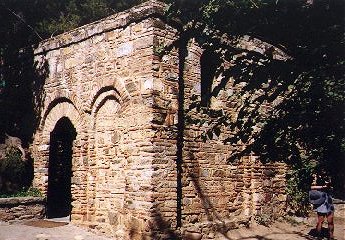 We found other information that says, The house of
Mary near Selcuk (and Ephesus). They say this is where Mary
lived with St. John the Apostle after Jesus' death
(John the Evangelist). The Roman Catholic church officially recognizes
this house as the house that Mary lived in. Sixteen kilometers
from Selcuk, on the slopes of Bulbuldagi (Nightingale Mountain, on THE SOUTH AEGEAN
COAST - Turkey) is the House of the Virgin Mary. Tradition says that
Mary came to Ephesus five years after Jesus' so-called death, to live
out the rest of her life.
We found other information that says, The house of
Mary near Selcuk (and Ephesus). They say this is where Mary
lived with St. John the Apostle after Jesus' death
(John the Evangelist). The Roman Catholic church officially recognizes
this house as the house that Mary lived in. Sixteen kilometers
from Selcuk, on the slopes of Bulbuldagi (Nightingale Mountain, on THE SOUTH AEGEAN
COAST - Turkey) is the House of the Virgin Mary. Tradition says that
Mary came to Ephesus five years after Jesus' so-called death, to live
out the rest of her life.
In John 19:25-27 , Jesus asks John to take care of his mother after his death. "Standing close to Jesus' cross were his mother, his mother's sister, Mary the wife of Clopas (Cleophas) and Mary Magdalene. Jesus saw his mother and the disciple he loved standing there; so he said to his mother, `He is your son.' Then he said to the disciple , `She is your mother.' From that time the disciple took her to live in his home." from John the apostle, however since this account has been edited, we conclude that Mary, the wife of Clopas (Cleophas) is actually Jesus' mother Mary. And the disciple that Jesus loved is probably Mary Magdalene. We also found proof that Mary lived in India with her son Thomas and she died there. More proof of this arises as we discover that Mary's other sons are Jesus' step brothers and their father is called 'Clopas'. It is not likely that Mary's sister is also called Mary so we have another Roman concoction to deny the marriage of Mary to Cleophas after Joseph died. Mary was not a virgin forever!
Bartholomew
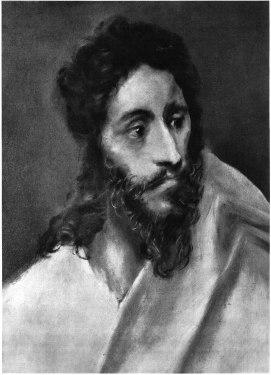 Bartholomew is listed in the Bible as being one of the
twelve apostles. He was with the other apostles after Jesus
ascended into heaven, but we know nothing more of him. The book,
Bloodline of the Holy Grail, by Laurence Gardner says
John Mark was known as Bartholomew and he
traveled to Galatia ( Central Asia Minor ) in 44AD with Jesus.
Another story says it is possible that he was the same person as
Nathaniel, the man whom Philip brought to Jesus as mentioned
in St. John's Gospel, whom Jesus described as "as Israelite,
in whom there is no guile."
Bartholomew is listed in the Bible as being one of the
twelve apostles. He was with the other apostles after Jesus
ascended into heaven, but we know nothing more of him. The book,
Bloodline of the Holy Grail, by Laurence Gardner says
John Mark was known as Bartholomew and he
traveled to Galatia ( Central Asia Minor ) in 44AD with Jesus.
Another story says it is possible that he was the same person as
Nathaniel, the man whom Philip brought to Jesus as mentioned
in St. John's Gospel, whom Jesus described as "as Israelite,
in whom there is no guile."
Nothing else is known of him, although later traditions suggest that he preached in Asia Minor, northern India, and in Armenia, where he was flayed alive and then beheaded - the basis for his patronage of tanners. Bartholomew is mentioned in Matthew 10:1 - 4, Acts 1:13, 14, Nathaniel is mentioned in John 1:45-51.
Matthias
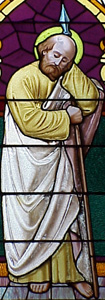 Profile; Apostle, he was chosen to replace Judas Iscariot.
Preached the Gospel for more than 30 years in Judea, Cappadocia,
Egypt and Ethiopia. Remembered for preaching the need for
mortification of the flesh with regard to all its sensual and
irregular desires. Martyr.
Profile; Apostle, he was chosen to replace Judas Iscariot.
Preached the Gospel for more than 30 years in Judea, Cappadocia,
Egypt and Ethiopia. Remembered for preaching the need for
mortification of the flesh with regard to all its sensual and
irregular desires. Martyr.
Died; stoned to death at Colchis in 80 AD; some relics in the abatical church of Triers, others in Saint Mary Major in Rome. Name Meaning - gift of Yahweh (Mattithiah) Patronage ( Patron Saint) of alcoholism, carpenters, reformed alcoholics, smallpox, tailors
An Interesting sentence found in the Catholic encyclopedia
while researching the name 'Matthias;..."Joseph, who was called
Barsabbas and surnamed Justus, and Matthias".... Was Joseph's
last name Matthias?
On our Jesus, Page 1
We have the writings of Josephus, It says;..
"Some also there
were who, watching a proper opportunity when
they might quietly get away, fled to the Romans, of whom were
thezz, high priests Joseph and Jesus,
and of the sons of high priests three, whose father was Ishmael, who was beheaded in
Cyrene, and four sons of Matthias, as also
one son of the other Matthias, who ran away after his father's
death, and whose father was slain by Simon the son of Gioras, with three of his
sons, as I have already related; many also of the other nobility
went over to the Romans, together with the high priests"..
War Book 6, chapter 2
Cleophas has four sons; James, Simeon,
Jude, and Jose. The 'Son' of the 'other' Matthias (Joseph
his brother) who ran away was most likely Jesus. This also
tells us that Cleophas, Jesus' step father, had other sons, probably
much younger than Jesus.
Josephus was a family member. His name was Matthias... see Josephus
When we researched this further we found that 'Joseph of Arimathea' is Joseph ben Matthias, Jesus's uncle. He is prominent in the story of Jesus's burial as he and Nicodemus bring Myrrh and Aloes to the cave, not to imbalm him, but to heal him of the wounds caused by the nails, the sword wound in his side and the crown of thorns. We also found information that says Jesus was beaten very badly. We explain this further on our hidden page, 'the Resurrection'.
Conformation; James A - St. James the Less or
St. James the Little. He was the son of Alphaeus; and his mother
Mary, was one of those at the cross and tomb. The Western Church
identifies him with Saint James, “the Lord’s brother”. The
father of James the Less is Alphaeus. ( thus James A )
An important
explanation is that Cleophas is the Aramaic form of Alphaeus.)
This is apparently Mary the mother of St. James the Less,
Thomas and Jesus, but the father of James the Less
is Alphaeus/Cleophas. One single paragraph in the Nag Hammidi
verifies this calling James, Jesus' 'stepbrother'.
The (Second) Apocalypse of James
We continue this story on The High Priests

|
 |
 |
 |
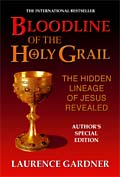 |
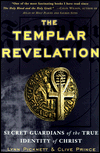 |
Search this site
Our search Engine does not search for the links in this site, only words in the text.
NO PART OF THIS SITE MAY BE COPIED OR REPRODUCED, IN WHOLE OR IN PART WITHOUT THE EXPRESS WRITTEN APPROVAL OF THE WEBMASTER... © COPYRIGHT 1999 - 2008 C.I.C.ALL RIGHTS RESERVED